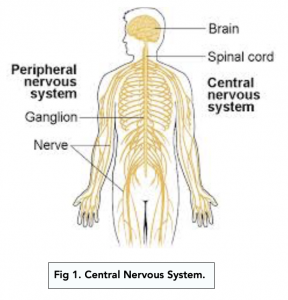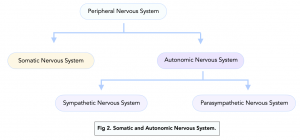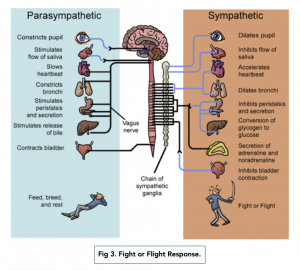The Nervous System (A-level Biology)
The Nervous System
Function of the Nervous System
The Central and Peripheral Nervous Systems
Functions of the human body can be divided into two groups: voluntary or involuntary. Voluntary acts include speaking and walking (movement); involuntary functions include heart rate and breathing.
The nervous system has three functions: sensation, integration and response.
- Sensation takes sensory information from the external environment or the body and analyses it.
- Integration is where information is stored for decision to be made about sensory responses.
- Response is the motor response that happens after muscles contract or glands secrete hormones.
Whether the functions are conscious or not, they are all controlled by the nervous system. The nervous system is composed of the central nervous system (CNS), which is the brain and spinal cord, and the peripheral nervous system (PNS), which is the nerve cells.

The Somatic and Autonomic Nervous Systems
The PNS can be further divided into two systems: the somatic nervous system, and the autonomic nervous system (ANS).
The somatic nervous system is made up of:
- Cranial (brain) nerves
- Spinal nerves
- Sensory neurones
- Motor neurones
Sensory receptors take external information to the brain and spinal cord, whilst the motor pathways are responsible for movement, controlled by the brain.
The overall function of the somatic nervous system is to:
- Relay information from the sensory receptors to the brain
- Provide a muscle response through the motor pathways
The autonomic nervous system is in control of automatic involuntary functions, playing an important role in homeostasis. It works to make sure the functions run without an issue and takes control during emergencies. Reflexes such as sneezing and coughing are also carried out by the ANS.
Nerves and ganglia (neuronal cell bodies) make up the autonomic nervous system. Ganglia connect organs around the body to the CNS. Within the ANS, there are two further systems: the sympathetic nervous system (SNS) and the parasympathetic nervous system (PSNS).

The Sympathetic and Parasympathetic Nervous Systems
The sympathetic nervous system prepares the body for any possible type of emergency. When the fight or flight response takes over, the SNS is activated. During the activation when the body is under stress, the heart rate and breathing increases in response to a release of adrenaline, as well as changes to the organ’s function. Pre- and post-ganglionic nerves send information between the central nervous system (CNS) and the sympathetic nervous system (SNS).
When we are not in an emergency situation and simply resting, our parasympathetic nervous system (PSNS) is in control of our involuntary functions. Our heart rate decreases whilst our digestion and salivation remains normal in order to preserve energy, and, if needed, counter-act the sympathetic nervous system’s work to return the body to its normal state.
The nerves of the PSNS, such as the vagus and cranial nerves, as well as ganglia, start in the CNS and reach the glands and organs it targets.

The nervous system is a complex network of cells, tissues, and organs that is responsible for controlling and coordinating the functions of the body. It collects and processes sensory information from the environment and internal organs, and then sends signals to the muscles and glands to produce a response.
The two main components of the nervous system are the central nervous system (CNS) and the peripheral nervous system (PNS). The CNS consists of the brain and spinal cord, while the PNS consists of all the nerves and ganglia outside of the CNS.
The brain is the central control center of the nervous system and is responsible for processing sensory information, controlling movement, regulating physiological functions, and storing and processing memories.
The spinal cord acts as a communication pathway between the brain and the rest of the body. It receives sensory information from the periphery, and sends motor commands to the muscles through the peripheral nerves. It also has reflex centers that allow for quick, automatic responses to stimuli.
Neurons are specialized cells that are responsible for transmitting electrical and chemical signals in the nervous system. They receive and process sensory information, transmit signals to other neurons or muscles, and integrate information from multiple sources to produce an appropriate response.
Neurotransmitters are chemical messengers that are released from neurons and bind to specific receptors on other neurons or muscles to transmit signals across synapses. They are involved in controlling the speed and strength of nerve impulses, and can also affect mood, behavior, and various physiological functions.
The nervous system works with the other systems of the body, such as the endocrine system, cardiovascular system, and respiratory system, to maintain a stable internal environment, known as homeostasis. The nervous system collects information about changes in the internal and external environment, and uses this information to activate responses that restore homeostasis.






Still got a question? Leave a comment
Leave a comment